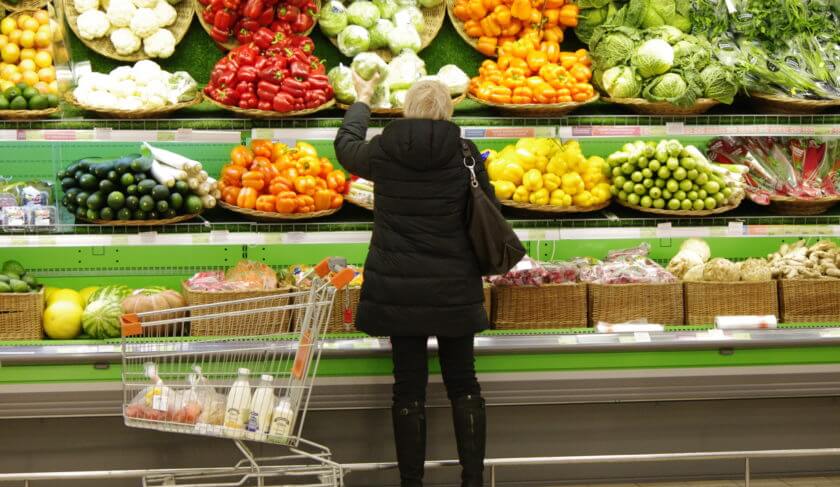
I’ve been carefully budgeting my food expenses for quite awhile. For a long time I’ve known that the best way for me to save money is find food to buy in bulk.
It seems counterintuitive to say that when we want to save money, we should buy more. Many experts recommend avoiding waste by buying only what you will need in a given moment and nothing more. True, but you’ll also tend to spend more per serving (or per ounce, or per pound). When you’re always buying in your moment of need, it’s rare that you get to take advantage of sales. Here’s why you should buy foods in bulk and how to save on groceries right now.
SUBSCRIBE: Get more money-saving tips straight to your inbox every week (for free!) when you subscribe to the HerMoney newsletter.
Why Should You Buy in Bulk?
I live alone in a tiny studio apartment. With no partner or children, it may sound silly to invest in a family pack of chicken breasts or a case of canned tomatoes. I do it because you end up spending so much less in the process. The key is that you can’t think of things in terms of your total purchase. Instead, you have to consider your final price per meal.
For example, you might spend $11 on that case of 10 cans of diced tomatoes at Costco. But if you price that out per-can at your local market, you’re probably looking at $2 per can, for a total of $20 by the time you buy the same number that’s in a case. You can’t compare your $40 bill at your local grocery store to your $300 bill at Costco — the two are not created equal.
What you always need to look at is your price per serving. And yes, it may take a little mental work on your part to get over the sticker shock of the initial outlay of said $300 Costco bill (and you might have to save up for those big monthly moments). In the long run, it’s so much more affordable to pay one of those large bills every few months than whittling your budget down with smaller nothing-is-on-sale $50 grocery bills every week.
The Best Foods to Buy In Bulk
What are the food staples that last the longest when you buy ahead? These experts dish about the best foods to buy in bulk and how you can save some serious cash in the process.
1. Bread
We all want fresh bread for our morning toast or lunchtime grilled cheese. But we also know that fresh bread doesn’t last. So store the bread in the freezer to make that bread last for months.
“It is best to store bread in the freezer instead of your counter,” says Lisa Moskovitz, RD, CEO of NY Nutrition Group and author of The Core 3 Healthy Eating Plan. “You can keep your bread mold-free for months as opposed to days.”
When you’re ready to use, take a few slices out and leave it on the counter to defrost or throw it in the toaster. During the pandemic, I ordered a dozen bagels, froze the batch, and defrosted them as I was ready for them. That dozen bagels lasted me months!
GET YOUR MONEY RIGHT: Join FinanceFixx — Jean’s money makeover program. You get a coach and quick results that’ll set you up for success right away.
2. Cereal
Cereal has long been established as something that is shelf-stable and lasts a good amount of time. But just how good a value and how long it lasts will depend on your storage method.
“Air-tight containers are super important to prevent your snack foods and cereals from getting stale,” says Moskovitz. “It also helps to store in a dark panty at room temperature.”
3. Bulk Proteins
Everything from a family pack of chicken thighs to a double-pack of ground beef can help you save substantially on your per-pound rate.
“[For example] Buy a 10-pack of chicken breasts, portion these out individually or into packs of two in freezer zip lock bags, then label, date, and freeze,” says Sara Heilman, Culinary Development Manager/Chef at EveryPlate. “These should store for up to one year.”
Pull out and thaw in the fridge 24 hours before use. These family packs of proteins are often as much as half the price per pound as what you’ll find for smaller portion packages.
4. Parmesan (and other hard cheeses)
We love our grated cheeses, but they don’t last that long. The good news is that parmesan cheese (and any hard cheese similar to Parmesan) freezes very well.
“Portion the cheese into smaller sections (or if buying shredded or grated, portion into smaller zip lock bags),” says Heilman. “Then wrap with plastic wrap or vacuum seal, label and date, and store in the freezer for up to 6 months.”
READ MORE: How To Meal Prep With A Limited Budget + Limited Time
5. Butter
Butter is another item that’s much cheaper in bulk and can actually last a long time when frozen.
“Bought in bulk, wrap the individual logs of butter with plastic wrap or vacuum seal, label and date, and store in the freezer for up to 6 months,” says Heilman.
You can move it to the fridge when you are ready for it. This is also good for any compound butters you make and want to save for a future date.
6. Eggs
Eggs do come with an “expiration date” but many chefs and culinary experts maintain that eggs, if stored properly in the fridge, will last as long as a month after this date.
“A good way to test the freshness of your eggs is to fill a bowl with 4 inches cold water and to gently place the egg into the bowl,” says Heilman. “If the egg sinks or stands up on one end, it is perfectly safe to consume. If the egg floats to the top of the water, discard the egg.”
This is good to keep in mind if at a warehouse store, like Costco, that offers eggs in larger containers at a better price.
7. Olive oil
Olive oil is one pantry staple that can get pretty pricey, especially when snagging an emergency bottle at your local market. Buying this in larger tins versus the smaller bottles can end up being an excellent value.
“Just make sure you keep it in a cool, dark place in your kitchen or else the oil may turn rancid and significantly cut down the shelf life,” says Moskovitz.
READ MORE: 10 Secrets to Affordable and Easy Meal Prep
8. Broths and Stocks
While you could make your own broth or stock to cut down even more on costs, not everyone has that kind of time. It’s great to have a few boxes or cans handy for when that’s not possible.
“I’ve found it very helpful to always have some kind of veggie or chicken broth/stock on hand in my kitchen,” says Heilman, who buys bulk containers.
If a recipe only calls for 1 to 2 cups, you can freeze the rest. You can also look into the super concentrated stock substance called “Better than Bouillon.” This keeps in your fridge for a year. All you need is to add water to make your own delicious broth. (Yes, they sell it at Costco!)
9. Fish
The same bulk protein-buying rules apply to fish as they do to other meat. But there’s another great option here.
“As a Nutritional Psychiatrist I am always touting the benefits of omega 3 fatty acids in mental health,” says Dr. Uma Naidoo, author of “This is Your Brain on Food,” is also a professional chef and nutrition specialist. “Fatty fish like Alaskan salmon are a great source but can be expensive. Canned salmon, mussels, and oysters are great brain foods and are relatively inexpensive. Look for those packed in water or extra virgin olive oil.” Those cans can last in your pantry for ages.
10. Plant-based Dairy
Dairy alternatives are also great pantry staples with tons of possibilities.
“You can find Tetra Pak containers of many non-dairy milks such as almond, soy, and coconut which will last in a pantry for six months or more,” says Dr. Naidoo.
This is great for times when you can’t get to the store and need something for coffee or cereal. There are also excellent non-dairy cheese options that are shelf-stable, including Daiya cheese sauce and powdered nutritional yeast that can be turned into your favorite cheesy dip or creamy base.
LISTEN: Download the HerMoney podcast or listen wherever you hear your favorite podcasts.
11. Nuts and Seeds
Nuts and seeds can be expensive, but they are an amazing source of healthy fats, including omega 3 fatty acids.
“When I see them on sale, I buy in bulk and store one airtight container in the pantry, with the rest in an airtight container in the freezer,” says Kacie Barnes, MCN, RD, owner/creator of mamaknowsnutrition.com. Because the oils in nuts can go bad, it’s best to keep them in the freezer long-term for freshness.
12. Canned Goods
Canned goods will last for years. It’s worth it to buy in bulk even if you won’t use them immediately.
“I look for low sodium beans and lentils, as well as canned tuna and salmon for high quality protein sources,” says Barnes. Another great canned good to have on hand is canned tomatoes. Whether crushed, diced, or pureed, these are perfect for sauces and can be a starter for everything from chili to a soup or stew.
READ MORE: Cheap and Quick Things to Eat Instead of Eggs







